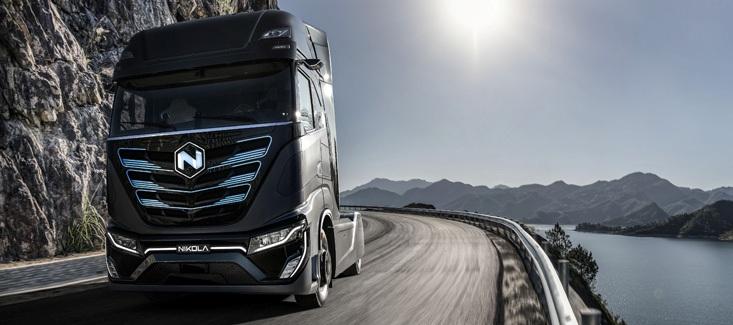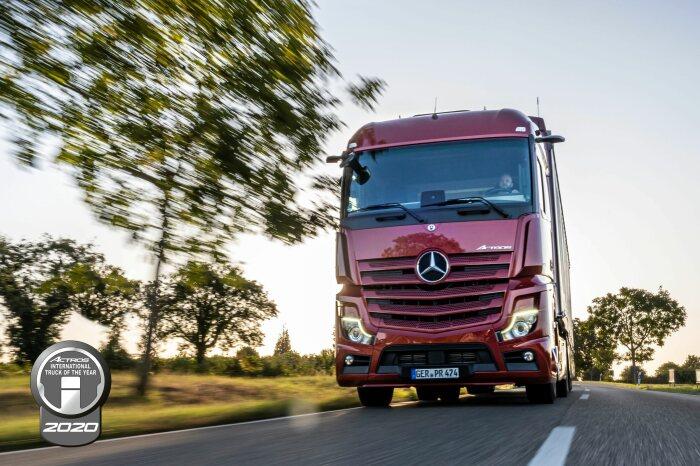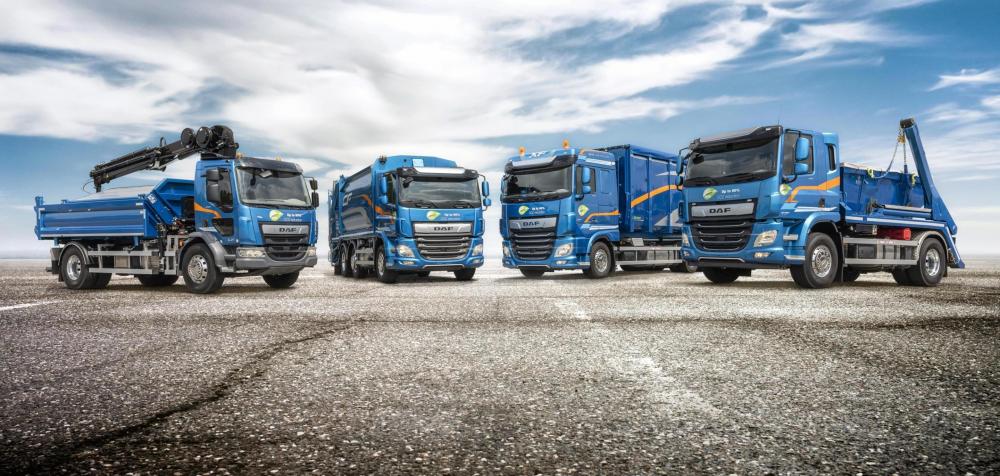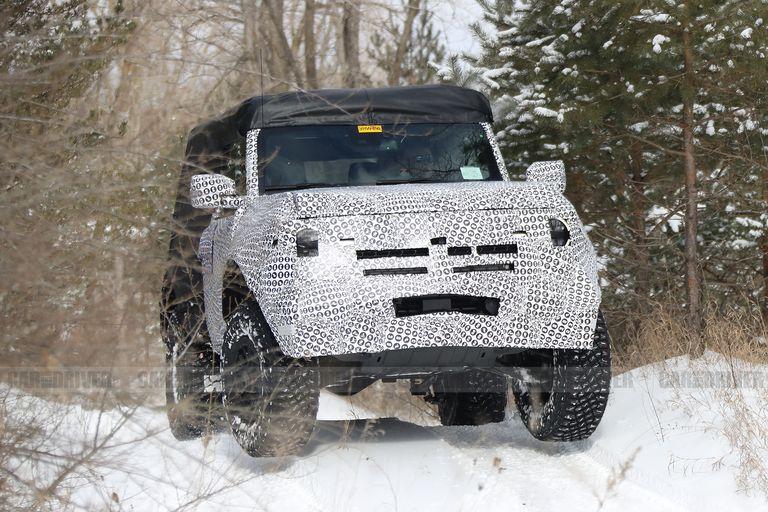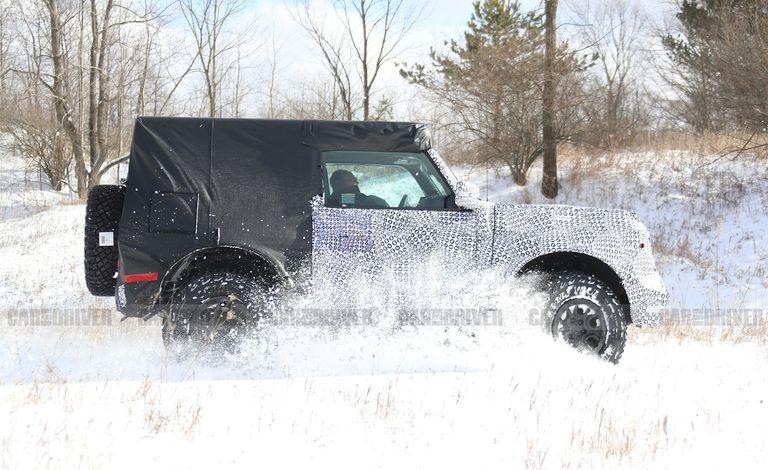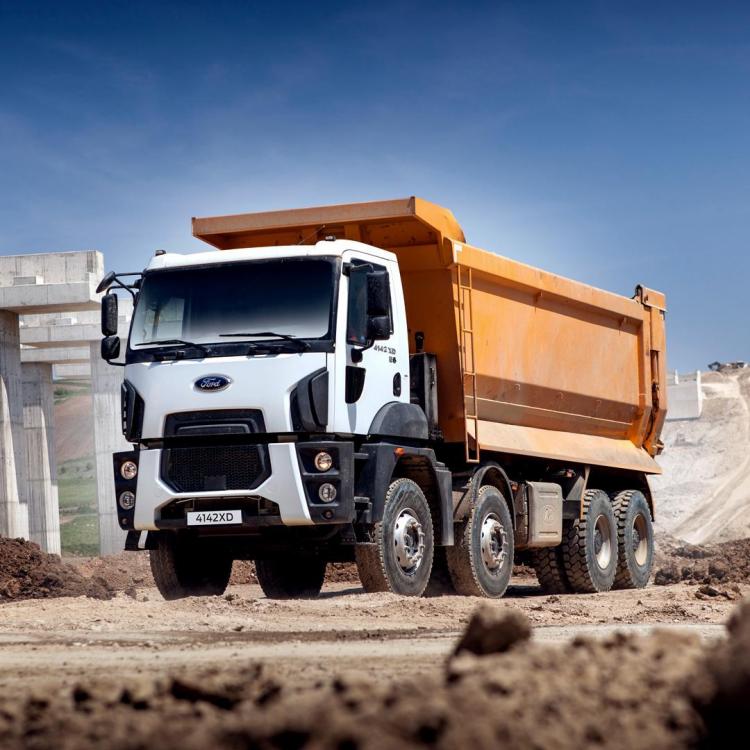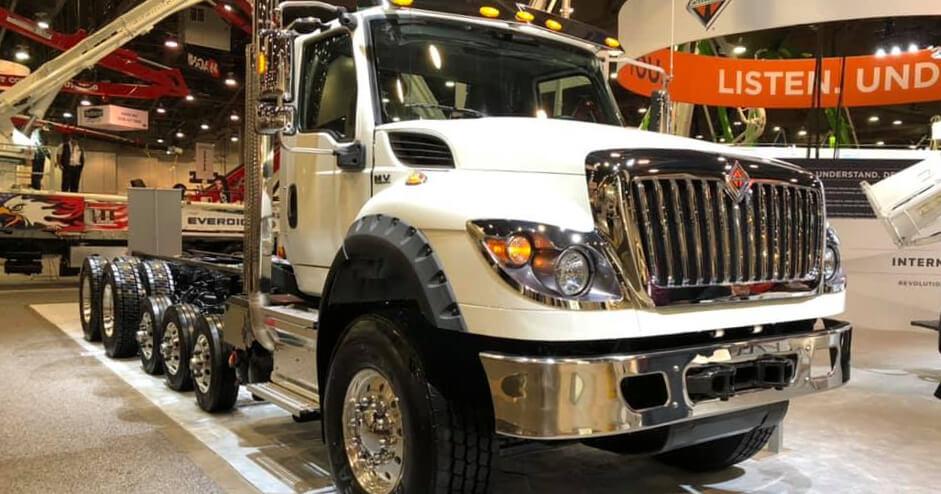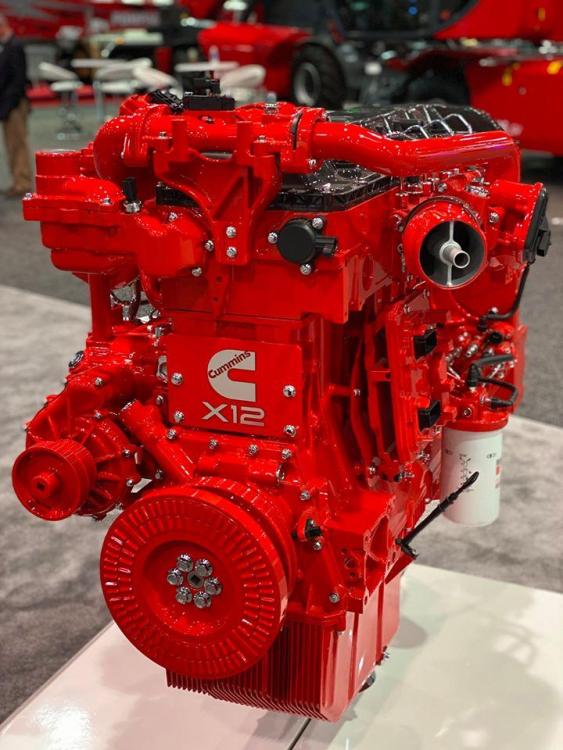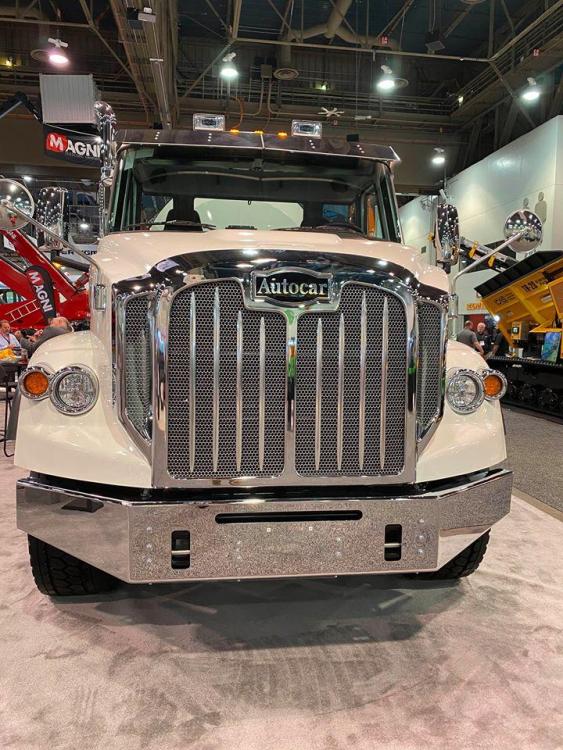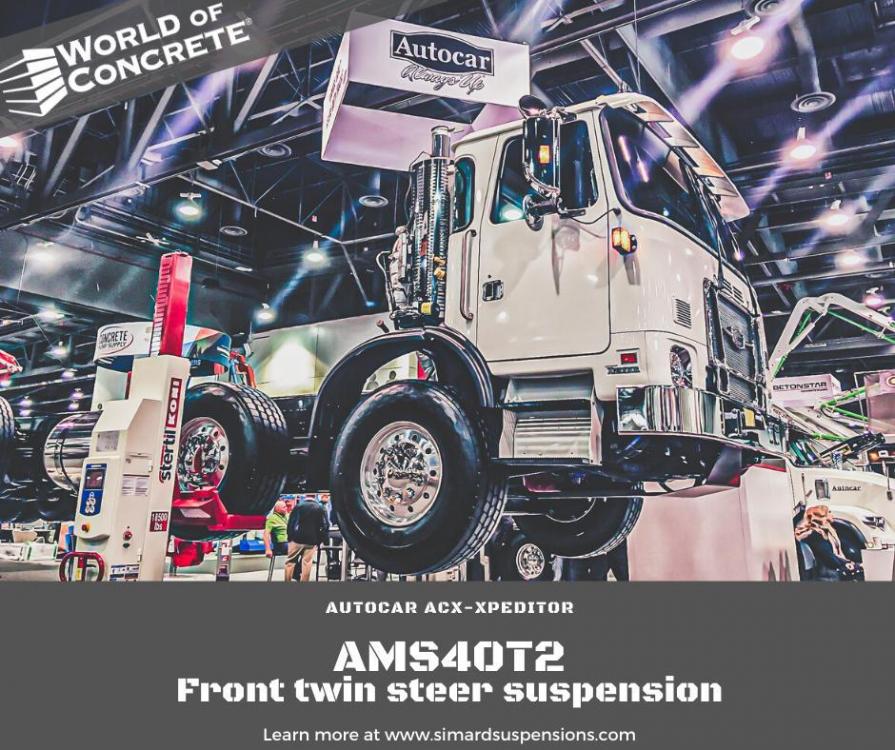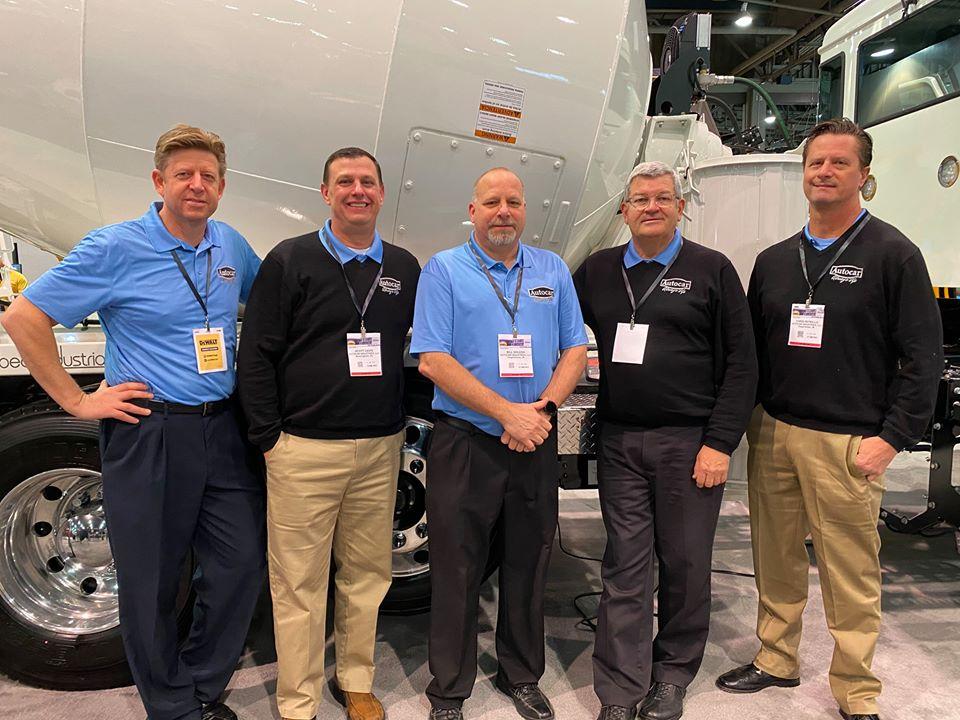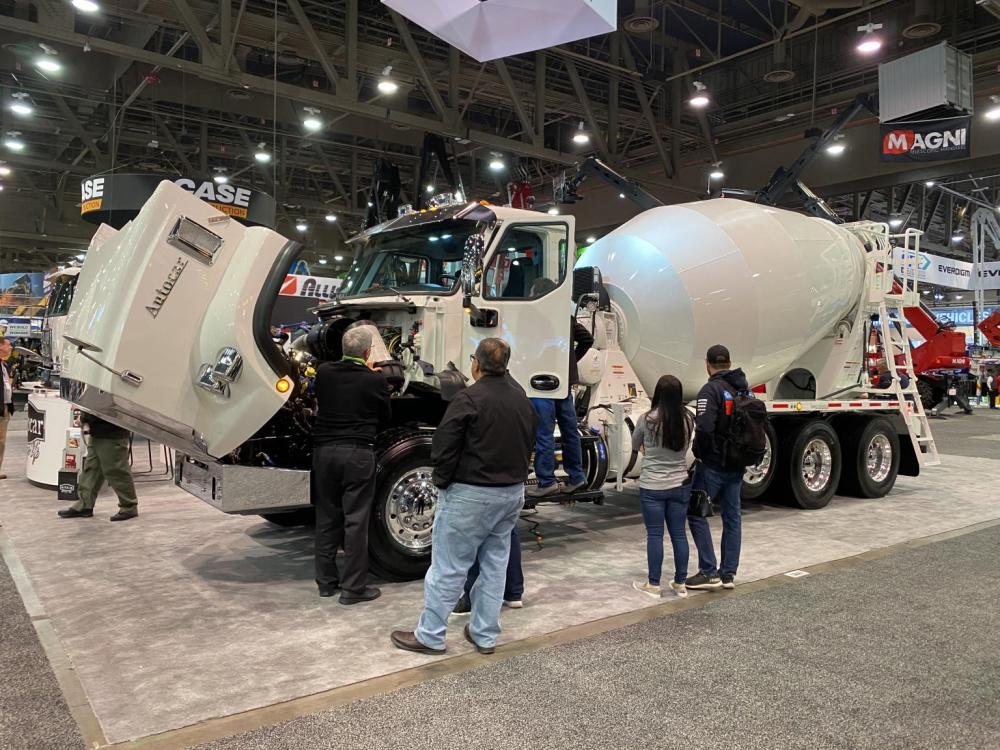
kscarbel2
Moderator-
Posts
18,905 -
Joined
-
Days Won
114
Content Type
Profiles
Forums
Gallery
Events
Blogs
BMT Wiki
Collections
Store
Everything posted by kscarbel2
-
CNH Industrial subsidiaries IVECO and FPT together with Nikola Motor Company IVECO Trucks Presss Release / February 6, 2020 The IVECO manufacturing facility in Ulm, Germany, will host the production hub for the Nikola TRE battery electric and fuel-cell electric heavy truck models. IVECO and FPT Industrial, the commercial vehicle and powertrain brands of CNH Industrial N.V. (NYSE: CNHI/ MI: CNHI), and Nikola Motor Company will manufacture, through their European Joint Venture, the Nikola TRE in Ulm, Germany, at the IVECO manufacturing facility. This strategic and exclusive Heavy-Duty Truck partnership saw CNH Industrial taking a $250 million stake in Nikola as the lead Series D investor. The partnership announcement at the CNH Industrial Capital Markets Day in September 2019, was quickly followed in December with the unveiling of the Nikola TRE, a battery electric vehicle (BEV) heavy duty truck, which is the first step towards the fuel-cell electric (FCEV) model. Today, the site in Ulm is IVECO’s chassis engineering hub, ideally situated at the heart of the Baden-Württemberg region, which is striving to become a leading hub for fuel-cell mobility thanks also to its skilled workforce and research labs. The region has committed a substantial investment to fund research and development projects in the area which has a strong automotive industry, with strategic project partnerships, meaning the Ulm facility will benefit from close proximity to key suppliers. Furthermore, the German Federal Government recently released its draft National Hydrogen Strategy, which has the aim of expanding the pioneering role of Companies in hydrogen technologies. In this strategy, it commits a total of two billion euro to fund the hydrogen innovation programme, incl. the development of the necessary distribution infrastructure. “Our European joint-venture with NIKOLA and today’s announcement, is real proof that zero-emission long-haul transport is becoming a reality, resulting in tangible environmental benefits for Europe’s long distance hauliers and its citizens,” said Hubertus Mühlhäuser, Chief Executive Officer, CNH Industrial. “The decision to build the Nikola TRE in Ulm – a center of heavy-duty truck engineering excellence – underscores the site’s strategic location at the heart of Germany’s fuel cell technology cluster.” In the first stage of the project, €40 million will be invested by the joint-venture Company to upgrade the manufacturing facility, which will focus on final assembly of the vehicle. Start of production is anticipated within the first quarter of 2021, with deliveries of the Nikola TRE beginning in the same year. “The Nikola TRE is proving to be the most advanced articulated truck in the world and will continue to set the standard for zero-emission vehicles today and in the future” said Trevor Milton, Chief Executive Officer, Nikola Motor Company. “The decision to volume produce the TRE in the city of Ulm is a fitting example of how to create jobs, foster innovation, provide certainty to new zero-emission part suppliers and serve as an example to other OEM’s. The world is ready for zero-emission freight transportation, and the joint venture between Nikola and IVECO will be the first to deliver. I look forward to seeing the first production vehicles come off the line.” The first models to enter production will be the battery-electric 4x2 and 6x2 articulated trucks with modular and scalable batteries with a capacity of up to 720 kWh and an electric powertrain that delivers up to 480 kW of continuous power output. The Ulm facility will receive module supplies from IVECO´s manufacturing locations in Valladolid and Madrid, Spain, which will enable a rapid ramp up to meet expected customer demand. Fuel-cell electric versions, built on the same platform, will be tested under the EU-funded H2Haul project during 2021 for an expected market launch in 2023. The Nikola TRE currently in development is based on the new IVECO S-WAY platform and integrates Nikola’s truck technology, controls and infotainment. Testing is expected to begin in mid-2020 with prototypes showcased at the IAA 2020 commercial vehicle exhibition in Hannover, Germany this September. “By drawing on our Gold standard World Class Manufacturing sites in Madrid and Valladolid, Spain, where the IVECO S-Way is produced, we are able to accelerate final assembly, powertrain integration and high-end customization of the Nikola TRE for a timely market introduction in 2021” said Gerrit Marx, President Commercial and Speciality Vehicles, CNH Industrial. This Joint Venture forms part of a wider partnership established with Nikola to accelerate industry transformation towards emission neutrality of Class 8 heavy-duty trucks in North America and Europe through the adoption of fuel-cell technology. The primary focus of the collaboration is to leverage each partners’ respective expertise to successfully deploy zero-emission heavy-duty trucks and to disrupt the industry with an entirely new business model. .
-
Daimler Press Release / February 7, 2020 Agriculture is the world’s oldest form of economy. Yet how has it managed to secure the world’s food supply for thousands of years? That is only possible when agriculture continually reinvents itself. Take the example of the sugar cane harvest in Brazil. The agricultural machinery manufacturer Grunner Tec in Sao Paolo has developed an automated vehicle combine from an Axor 3131 and a combine harvester that works in parallel. The system not only increases yields, but also operates very fuel-efficiently. Thanks to engineers such as Mateus Belei from Grunner Tec, agriculture is already benefiting from a technology that will shape mobility in the future. Mateus is one of many heroes of everyday life who keep our world moving. .
-
- 1
-

-
Daimler Press Release / January 31, 2020 When we go to the movies we naturally expect to be able to buy popcorn. But how does it get there? We owe it to Pat Green, for example, who grows corn in the vastness of Nebraska together with his daughter as fourth–generation farmers. Or to the American Popcorn Company, which processes corn from Pat and many other farmers into popcorn and sells it under the Jolly Time brand. And, of course, people like Jacob Person who make sure that the corn gets to the factory and the popcorn arrives at the cinemas. As a driver at K&B Transportation he has already covered more than 1.5 million miles with his Freightliner truck and is one of many everyday heroes who keep our world moving. .
-
- 1
-

-
Daimler Press Release / February 6, 2020 The new Actros is "International Truck of the Year 2020" Numerous further prizes are testimony to the innovations found in Mercedes-Benz trucks Added safety, efficiency and connectivity in everyday transport life: since the summer of 2019, the new Actros has been proving its worth to more and more customers across Europe So far unique in the market: Active Drive Assist allows partially automated driving, while the MirrorCam replaces conventional rear-view mirrors Latest-generation advanced emergency braking assist system for added safety on the road Fuel savings of up to five percent thanks to optimised aerodynamics and even more effective Predictive Powertrain Control Multimedia Cockpit, Mercedes Truck App Portal and more: countless innovations ensure a high level of connectivity Stuttgart – the new Actros is a compelling proposition – first of all in daily operation with more and more European transport companies, and then also as the winner of numerous awards across the whole of Europe. Such awards underline the fact that the flagship of Mercedes-Benz Trucks continues to set standards for safety, efficiency and connectivity. The new Actros is the truck for the 2020s. The most significant prize from a European perspective is the "International Truck of the Year 2020" award. "With the introduction of the new Actros, Mercedes-Benz has brought a highly sophisticated truck onto our roads which smooths the way to the automated driving of the future", was the rationale for the award as explained by jury chairman Gianenrico Griffini. The committee, comprising specialist commercial vehicle journalists from 24 countries, cited Active Drive Assist as well as further innovations such as the enhanced cruise control and transmission intervention system Predictive Powertrain Control, the fully digital Human Machine Interface in the form of the Multimedia Cockpit and the state-of-the-art safety systems, including the improved emergency braking assistance system Active Brake Assist 5, among the reasons for the award. Throughout the history of the "Truck of the Year" award, Mercedes-Benz has not only been its most frequent recipient, but has also won the competition, the most important for the industry in Europe, with all previous versions of the Actros. In 2019, the "Ferdinand Porsche Prize" of the Technical University of Vienna, a widely respected award presented to leading automotive developers, also acknowledged the innovative strength of the new Actros: Professor Dr Uwe Baake, Head of Product Engineering at Mercedes-Benz Trucks, and Dr Werner Lang, Managing Director of MEKRA Lang GmbH & Co. KG, were honoured jointly for their development of the MirrorCam in the new Actros, fitted here for the first time in a series-production truck. While the "Truck of the Year" award reflects the views of journalists and the "Porsche Prize" those of engineers, the "Truck of the Year Austria – Driver's Choice" award from the online magazine "1Truck.tv" is based on the opinion of truck drivers. Some 6000 votes went to the new Actros in this instance, setting it well ahead of its competitors. But that's not all: the truck has also been the recipient of numerous further accolades in other countries. In Spain the vehicle was voted "Camión de Año en España 2019" by more than 100 journalists and truck experts. The Catalan industry federation Transcalit awarded the truck the prize for "Innovation en el Transporte 2019". Specialist magazine "Fleet Transport" in Ireland, meanwhile, distinguished the new Actros with the "Truck Innovation Award 2020". And the Italian commercial vehicle magazine "Vado e Torno" declared the new Actros the "Sustainable Truck of the Year 2020". In the view of the magazine's editors in Milan, the vehicle marks a "powerful turning point that will bring long-term change to the way trucks are perceived, as well as to the way transport tasks are undertaken in the future". Partially automated driving for the first time in all speed ranges – courtesy of Active Drive Assist As the award juries and many customers agree: Active Drive Assist is one of the outstanding features of the new Actros. For the first time in a series-production truck, this system allows partially automated driving in all speed ranges – so bringing about significant improvements in safety. It is capable of automated braking, acceleration and steering. It achieves this by networking the performance of individual systems in a unique way: as an extension of Proximity Control Assist with stop-and-go function, Active Drive Assist can maintain the distance to the vehicle driving ahead as set. Furthermore, Active Drive Assist can bring the truck back into lane with a corrective steering intervention, within system limits. "I wouldn't like to be without the system now, as I find it really helps me", says Elias Salonen. As a driver for Vähälä Logistics in Finland, he has been one of the first to test Active Drive Assist as part of a pilot project. "I often cover long distances, with not a lot happening, so Active Drive Assist acts as an attentive co-driver, as it were, who occasionally gives me a useful little nudge. When there's a lot of traffic, on the other hand, Active Drive Assist helps me to maintain an appropriate distance from the vehicle in front." Small camera arms replace large exterior mirrors: the MirrorCam ensures excellent visibility Safety is further enhanced by an additional feature that no other truck yet has on board: the MirrorCam. The major advantage of this system: it vastly improves the driver's direct line of view through the side windows. Instead of the conventional type of exterior mirrors, which can obstruct the view of the person at the wheel in many situations, the MirrorCam works with small camera arms mounted to the left and right of the roof frame. This configuration improves safety, particularly when approaching junctions and roundabouts, when manoeuvring and in tight bends. The camera images are transmitted to two vertical-format monitors mounted to the A-pillars of the cab. As with a conventional mirror system, the monitor image is split between a main view and a wide-angle field of vision. In many situations, the MirrorCam can actively support the driver: The distance lines in the MirrorCam display, for example, are a useful aid, enabling the driver to better estimate distances to objects behind their own truck. A further significant benefit of the MirrorCam: the substitution of the classic mirror housings with the aerodynamically designed camera arms has also reduced the area on the cab open to attack from the oncoming wind. This aerodynamic plus, which is further helped by new rear-edge flaps, reduces the consumption of the already fuel-efficient Actros by a further significant margin – as established, for example, by transport operator Dominik Böpple from the German town of Esslingen: "The new Actros uses as much as three percent less fuel on motorways and fast roads as its predecessor, and as much as five percent less on country roads." Predictive Powertrain Control more effective than ever – can now also be used on cross-country routes Also contributing to the reduction in fuel consumption is the improved cruise control and transmission intervention system Predictive Powertrain Control, which can now also be used on cross-country routes. In addition to a satellite-based positioning system, the new-generation system uses accurate digital road maps that contain data about topography, road bends and the geometry of intersections and roundabouts, as well as about traffic signs. The system thus doesn't just optimise driving style on uphill and downhill gradients on motorways and fast roads, but also on cross-country routes where, until now, the use of cruise control has not been particularly practicable. This is something that Franz Birgmann, for example, has come to appreciate in his role at Lagermax in Salzburg, Austria, where he is responsible for a fleet of 530 car transporters. "Covering, as we do, a distance of more than 100,000 kilometres annually per vehicle, any little percentage point that we can economise is important for the success of our business." Even more safety thanks to Active Brake Assist 5 and Sideguard Assist as standard There's another new key feature that has helped the new Actros to take a further step forward in terms of safety: Active Brake Assist 5, which since the beginning of 2020 has been part of the standard specification for Actros and Arocs in those European countries where an advanced emergency braking assistance system is prescribed by law. This latest version of the tried and tested emergency braking assistant works with a combination of radar and camera systems. Amongst other things, the reaction to moving individuals in the speed range up to 50 kilometres per hour has been improved. The new Actros also sets a benchmark with its Sideguard Assist system: in 2016, the vehicle became the first truck to feature a cornering assistance system that was fully integrated into the vehicle architecture. The warning system minimises the likelihood of dangerous accidents occurring on the co-driver's side of the vehicle during a nearside turn. During the course of development of the new Actros, Sideguard Assist was linked to the mirror camera system. The system now works hand in hand with the MirrorCam: if Sideguard Assist is installed, the MirrorCam display shows the warning messages of that system in critical driving situations. All hints and indicators of relevance for the driver are thus grouped in one place – which avoids the driver being overwhelmed with information. It is not least with reference to Active Brake Assist 5 and Sideguard Assist that transport operator Klaus Wagenstetter is able to summarise: "With the assistance systems, Mercedes-Benz Trucks offers a complete package which works harmoniously to sustainably improve the safety and economic efficiency of our business." The new Actros as part of the "Internet of Things" – for added economic efficiency and comfort The development engineers working on the new Actros were keen to configure it systematically, right from the start, for a networked world. The truck is permanently connected to the cloud and thus part of the "Internet of Things". The basis for all connectivity solutions is the Truck Data Center. It receives data from the sensors, cameras, etc., in the truck and analyses them for different applications. This gives company owners and fleet operators real-time control of the truck via Fleetboard and Mercedes-Benz Uptime – with the objective of significantly improving the ability to plan jobs, workshop visits and downtimes and so of delivering a clear increase in vehicle availability. The drivers, too, benefit from the connectivity solutions in the new Actros: with the new Multimedia Cockpit. The first fully digitalised cockpit in a series-produced truck brings hitherto unknown operating possibilities and improved operating convenience. For example, through the integration of Apple CarPlay and Android Auto. The Multimedia Cockpit has two large displays. The primary display replaces the conventional instrument cluster. All the assistance systems and the new traffic sign recognition function are shown here, for example. A second touchscreen on the instrument panel serves to operate selected apps from the Mercedes-Benz Truck App Portal along with virtual switches, as well as for the representation of the new navigation system. "Our aim is to give drivers the best possible tool for their stressful job", says Jerry Bodry, managing partner of GTS Logistik, a logistics company based in the German town of Traben-Trarbach. "They should be able to enjoy as much comfort and convenience as possible while they are in their truck. The modifications to the driver's workplace provided by the Multimedia Cockpit are an important part of this." In a nutshell: For representatives from the media, universities, transport companies and truck drivers, the new Actros represents a milestone in truck design. The "Truck of the Year 2020" benefits from countless state-of-the-art new features, and its innovations mark the way forward for the haulage sector. .
-
DAF Trucks Press Release / February 5, 2020 2019 was a good year for DAF Trucks. Its market share of 16.2% in the heavy duty (16+ tonne) segment puts DAF in the Top 3 of largest truck manufacturers in Europe. DAF’s share of the market in the light segment grew from 9.0% to 9.7%. “Our first class trucks and services, combined with an excellent dealer network, put us in a strong position to achieve further growth.” Harry Wolters, president of DAF Trucks In 2019, the European truck market for the 16+ tonne segment totalled 320,000 trucks, more or less the same number as the year before. “The European economy was strong last year, which led to a high demand for transport, including new trucks,” says Harry Wolters. “Our market share of 16.2% in the heavy segment is the second highest in the history of DAF.” Market leader in 6 European countries DAF continued as the market leader in the heavy segment in the Netherlands (31.8%), the UK (29.4%), Poland (22.0%) and Hungary (23.8%). The Dutch truck manufacturer also gained market leadership in 2019 in Belgium and Luxembourg (19.4%) and Bulgaria (23.6%). In the Czech Republic, Lithuania and Greece, DAF was number one in heavy tractors, while in France, the second largest truck market in Europe, it was the most popular imported tractor brand. Significantly larger market share in 6-16 tonne segment The European market for medium duty trucks (6-16 tonne) grew from 51,900 to over 53,600 units last year. DAF’s market share rose to 9.7% (2018: 9.0%). DAF is the market leader in the medium duty segment in the UK (34.8%) and the biggest-selling European brand in Ireland (19.1%). Further growth outside Europe DAF sold 7,900 trucks outside Europe. The company introduced the new generation of Euro 5 and Euro 6 trucks to Russia, Belarus, Ukraine, Latin America, Australia and New Zealand. In Taiwan, DAF remained the market leader amongst European brands in the heavy segment. In South Africa, sales rose by more than 20%, whilst in Bayswater, Australia, production of the versatile DAF CF commenced in the factory of parent company PACCAR. DAF also sold more than 3,000 PACCAR engines to leading manufacturers of coaches, buses and specialised vehicles all over the world. ‘Record after record’ “In 2019, we sold a record number of DAF MultiSupport Repair and Maintenance contracts, supplied a record number of clients with the DAF Connect online fleet management system, and delivered a record number of DAF Used Trucks to their new owners,” says Richard Zink, member of the Board of Management with responsibility for Marketing and Sales. “There certainly is no shortage of ambition, and that is why we are working together with our dealers to strategically expand our network of over 1,100 professional dealers and service points. Last year, for example, we opened our own dealership just north of Paris, whilst our independent dealers opened a total of 50 new dealerships in Europe, South America, Asia and Africa.” Ready to grow further In 2019, DAF produced 52,746 CF and XF Series trucks and 11,344 LF Series vehicles. “European truck demand remains strong due to steady European economic growth,” according to Harry Wolters. “We expect 2020 to be another good year for the European commercial vehicle market, but down on 2019, and in the range of 260,000 - 290,000 trucks. And we are ready to grow further, too – the market values, the reliability, low operational costs and high level of driver comfort of our fantastic trucks. Furthermore, our comprehensive range of tractors and vocational trucks offers tailor-made solutions for all transport requirements.” .
-
Daimler launches Mitsubishi Fuso eCanter in US market
kscarbel2 replied to kscarbel2's topic in Trucking News
-
PRNewswire / February 7, 2020 PITTSBURGH -- The United Steelworkers (USW) today called on Navistar International Corporation (NYSE: NAV) to negotiate in good faith for a fair contract to end an ongoing strike by about 85 members of Local 1636 in Joliet, Ill. Union members have maintained pickets at the plant since Monday, Feb. 3, 2020, after overwhelmingly rejecting a contract proposal last week. USW District 7 Director Mike Millsap said that members of Local 1636 have earned a fair contract with improved compensation, benefits and working conditions, but as Navistar management has proposed it, some workers will go without pay increases for as long as 12 years. "Our brothers and sisters have worked and sacrificed for the sake of the company and to keep their plant operating," Millsap said. "Volkswagen offered to buy Navistar for close to $3 billion last week, but what's a company worth without the loyal men and women who built it?" Millsap said that the union is ready and willing to meet with Navistar management to conclude bargaining and end the labor dispute as soon as possible with a fair contract.
-
Umm..........what ????? China as of January 2020 has US$3.115 trillion* in foreign exchange reserves. Why would we give another country free money........that has more money than our deficit-ridden country has????? The way tax-payer money is senselessly handed out overseas by the pallet load should be a crime. * https://www.reuters.com/article/china-economy-forex-reserves/chinas-jan-forex-reserves-rise-to-3-115-trillion-idUSAZN02BXSZ
-
US offers $100 mln to China, others to fight coronavirus AFP / February 7, 2020 Washington - The United States on Friday offered up to $100 million to China and other impacted countries to combat the fast-spreading coronavirus. "This commitment -- along with the hundreds of millions generously donated by the American private sector -- demonstrates strong US leadership in response to the outbreak," Secretary of State Mike Pompeo said. "We encourage the rest of the world to match our commitment. Working together, we can have a profound impact to contain this growing threat," he said. Pompeo said the United States would provide the assistance either directly or through multilateral organizations. He said the spending would come out of unspecified funds [???] that have already been allocated within the US government.
-
Nikola to Build Tre Electric Truck for Europe in Germany Jack Roberts, Heavy Duty Trucking (HDT) / February 6, 2020 One of the nagging unknowns concerning many of the electric truck startup companies breaking into trucking is how they will handle large-scale production once demand for their vehicles ramps up. Now, Nikola Motor Company has announced how it will produce its forthcoming Tre model in Europe. On February 6, Italy-based CNH Industrial's Iveco and FPT business units together with Nikola announced future Nikola Tre production will take place at an Iveco plant in Ulm, Germany. The companies said the strategic and exclusive heavy-duty truck partnership will have CNH Industrial taking a $250 million stake in Nikola as lead Series D investor. The Nikola Tre, a battery-electric heavy-duty truck is described as the first step towards the comapny producing a fuel-cell electric truck model. Today, the site in Ulm serves as Iveco’s chassis engineering hub. Nikola said the facility is “ideally” situated at the heart of the Baden-Württemberg region, which is striving to become a leading hub for fuel-cell mobility thanks to its skilled workforce and research labs. Additionally, Iveco noted that local governments and business groups in the area have committed a substantial investment to fund research and development projects in the area. Another strong point, Nikloa said, is the strong automotive industry presence there, with strategic project partnerships in the area that gives the Ulm facility close proximity to key suppliers. Furthermore, Nikola noted in a press release on the joint venture, the German Federal Government recently released its draft National Hydrogen Strategy, which aims to expand the pioneering role of companies engaged in hydrogen technologies. This strategy commits a total of €2 billion ( $2.2 billlion) to fund the hydrogen innovation program, including the development of the necessary distribution infrastructure. “Our European joint venture with Nikola and today’s announcement, is real proof that zero-emission long-haul transport is becoming a reality, resulting in tangible environmental benefits for Europe’s long distance fleets and its citizens,” said Hubertus Mühlhäuser, CEO of CNH Industrial. “The decision to build the Nikola Tre in Ulm – a center of heavy-duty truck engineering excellence – underscores the site’s strategic location at the heart of Germany’s fuel cell technology cluster.” In the first stage of the project, €40 million ($4.4 million) will be invested by the joint-venture company to upgrade the manufacturing facility, which will focus on final assembly of the vehicle. Start of production is slated for the first quarter of 2021, with deliveries of the Nikola Tre beginning that year. “The Nikola Tre is proving to be the most advanced articulated truck in the world and will continue to set the standard for zero-emission vehicles today and in the future,” said Trevor Milton, Nikola CEO. “The decision to volume produce the Tre in the city of Ulm is a fitting example of how to create jobs, foster innovation, provide certainty to new zero-emission part suppliers and serve as an example to other OEMs. The world is ready for zero-emission freight transportation, and the joint venture between Nikola and Iveco will be the first to deliver." The first models to enter production will be battery-electric 4x2 and 6x2 articulated trucks with modular and scalable batteries with a capacity of up to 720 kWh and an electric powertrain that delivers up to 480 kW of continuous power output, Milton said. The Ulm facility will receive module supplies from Iveco’s manufacturing locations in Valladolid and Madrid, Spain, which will enable a rapid ramp-up to meet expected customer demand. Fuel-cell electric versions, built on the same platform, will be tested under the EU-funded H2Haul project during 2021 for an expected market launch in 2023. The Nikola Tre currently in development is based on the new Iveco S-Way platform and integrates Nikola’s truck technology, controls and infotainment systems. Testing is expected to begin in mid-2020 with prototypes showcased at the IAA 2020 commercial vehicle exhibition in Hannover, Germany, this September. “By drawing on our Gold standard World Class Manufacturing sites in Madrid and Valladolid, Spain, where the Iveco S-Way is produced, we are able to accelerate final assembly, powertrain integration and high-end customization of the Nikola Tre for a timely market introduction in 2021,” said Gerrit Marx, president of Commercial and Speciality Vehicles for CNH Industrial. Nikola noted the production joint venture forms part of a wider partnership established to accelerate industry transformation towards the "emission neutrality" of Class 8 heavy-duty trucks in North America and Europe by adopting fuel-cell technology. The primary focus of the collaboration is to leverage each partners’ respective expertise to successfully deploy zero-emission heavy-duty trucks and to disrupt the industry with an entirely new business model, the company added.
-
Truckmakers Get Record $3.24 Billion EU Fine for Cartel
kscarbel2 replied to kscarbel2's topic in Trucking News
Daimler, Volvo Win Dismissal of $950 Million Cartel Suit Transport Topics / February 7, 2020 Daimler AG, Volvo AB and other truck makers won dismissal of a 867 million-euro ($950 million) lawsuit claiming customers were overcharged in a price-fixing cartel. The way the plaintiff in the case acquired the claims was invalid so the pooled cases can’t proceed, presiding judge Gesa Lutz said when delivering the ruling in Munich on February 7. The action also targeted Volkswagen’s MAN unit, Paccar’s DAF and CNH Industrial’s Iveco. The case was brought by Financialright GmbH on behalf of more than 3,200 companies that say they paid too much for their vehicles because prices were fixed. Lawyers for the truck makers had asked to dismiss the suit, arguing that buying the claims violated the law. The ruling is a setback for the purchase model invented to make up for Germany’s lack of U.S.-style class actions. Financialright is cooperating with BGL, a German association of logistics companies, and Burford Capital, which is financing the litigation. They have also filed a second group case in Munich. “We made an offer to the justice system and the defendants to handle these claims swiftly and efficiently,” said Jan-Eike Andresen, Financialright’s founder. “We will now consider all options, including bringing the cases individually.” The court criticized how, under the Financialright model, all claims would be treated the same, regardless of their individual chances. This would allow customers with poorer cases to profit disproportionately from a potential settlement at the expense of holders of better-founded claims. It also took issue with the litigation being financed by a “foreign” company owned by a listed corporation. As a publicly traded company is under scrutiny by analysts and the press, it may take decisions that are not motivated by the interest of the claimants. “Since the plaintiff is dependent on litigation funding, there’s a concrete risk that undue criteria will influence on how the case is led which aren’t in the interest of the customers,” the court wrote. -
The United States Centers for Disease Control & Prevention (CDC) estimates that influenza was associated with more than 35.5 million illnesses, more than 16.5 million medical visits, 490,600 hospitalizations, and 34,200 deaths during the 2018–2019 influenza season. https://www.cdc.gov/flu/about/burden/2018-2019.html There were 490,600 hospitalizations and 34,200 deaths during the 2018–2019 season. More than 46,000 hospitalizations occurred in children (aged <18 years); however, 57% of hospitalizations occurred in older adults aged ≥65 years. Older adults also accounted for 75% of influenza-associated deaths, highlighting that older adults are particularly vulnerable to severe outcomes resulting from an influenza virus infection. An estimated 8,100 deaths occurred among working age adults (aged 18–64 years), an age group that often has low influenza vaccination uptake.
-
Please correct me if I'm wrong........I don't think the expeditor market is anywhere as big as it was at the peak some years ago.
-
International shows new options at World of Concrete 2020
kscarbel2 replied to kscarbel2's topic in Trucking News
It's invaluable to hear a first-hand educated opinion from one of us. Thank you! -
Yes.
-
International Trucks is showcasing several vehicles from its vocational lineup this week at World of Concrete, including an International #HVSeries featuring the Hendrickson HAULMAAX EX suspension. #WOC2020 https://bit.ly/373PIFw
-
In the same vein that the Kenworth T440 and T470 have a deeper cab, a modification of the T270/370 cab. https://www.kenworth.com/media/9819/kenworth_t440_brochure.pdf
-
You’re right. But the powers that be don’t want it to publicize it. i suspect though that the Coronavirus is more contagious.
-
Now they have a longer version. .
-
The Cummins X12 engine—less weight, more freight. Plus, improved fuel economy for your Autocar DC-64 conventional cab vocational truck. Always Up - Autocar Trucks .
-
Autocar Model ACX "Xpeditor" equipped with Simard AMS40T2 "twin steer" front suspension at World of Concrete 2020. Learn more about the Simard AMS40T2 "twin steer" front suspension: https://www.simardsuspensions.com/en/products/front-suspension/ams40t2/ .
-
Definitely the best-looking crew at World of Concrete 2020! #AlwaysUp #Autocar #concretemixers #concretepumpers #concrete
-
The new #Autocar DC-64M #concretemixer has been drawing a crowd all day. Visit us in booth C-6661 if you haven’t seen it yet! #AlwaysUp #ROI #uptime #dieselconventional #concrete
BigMackTrucks.com
BigMackTrucks.com is a support forum for antique, classic and modern Mack Trucks! The forum is owned and maintained by Watt's Truck Center, Inc. an independent, full service Mack dealer. The forums are not affiliated with Mack Trucks, Inc.
Our Vendors and Advertisers
Thank you for your support!


